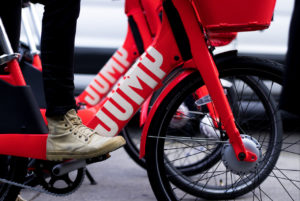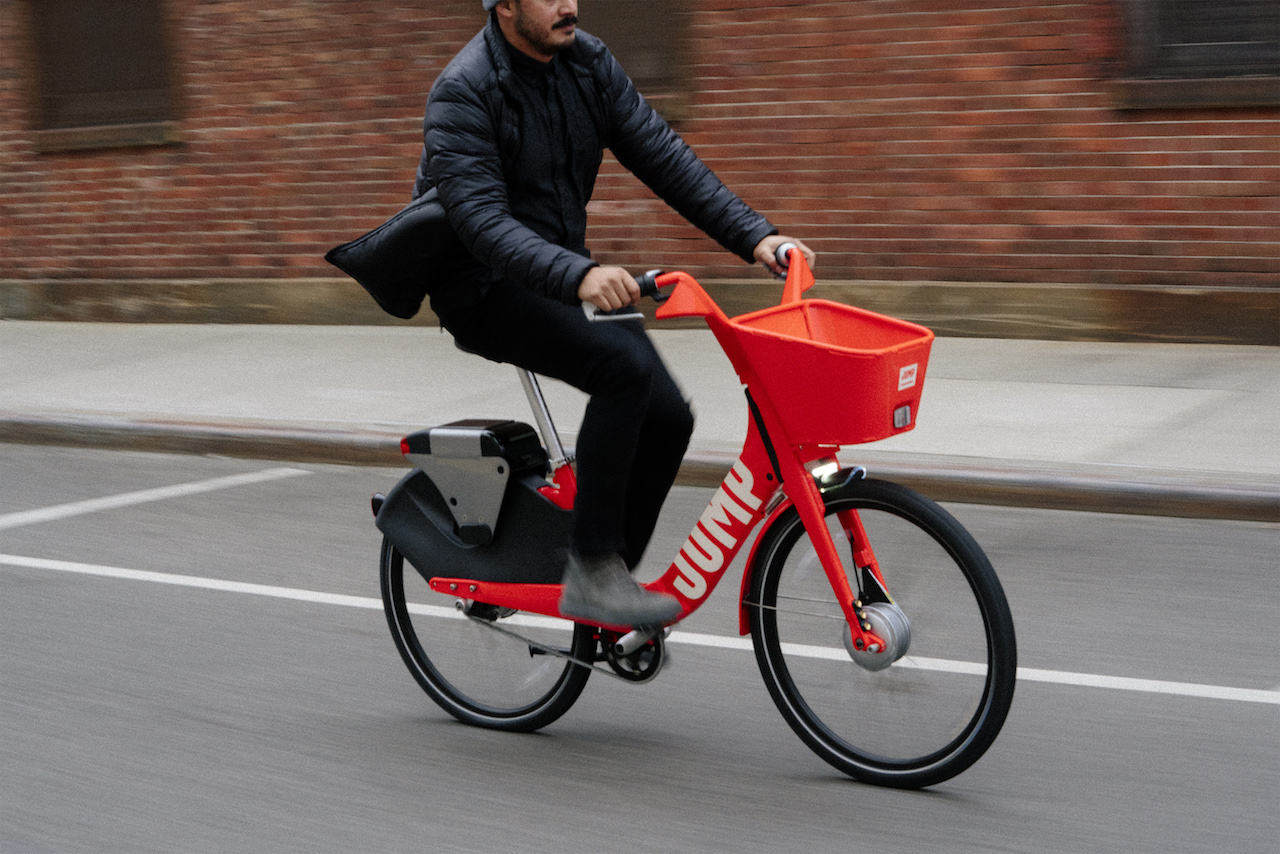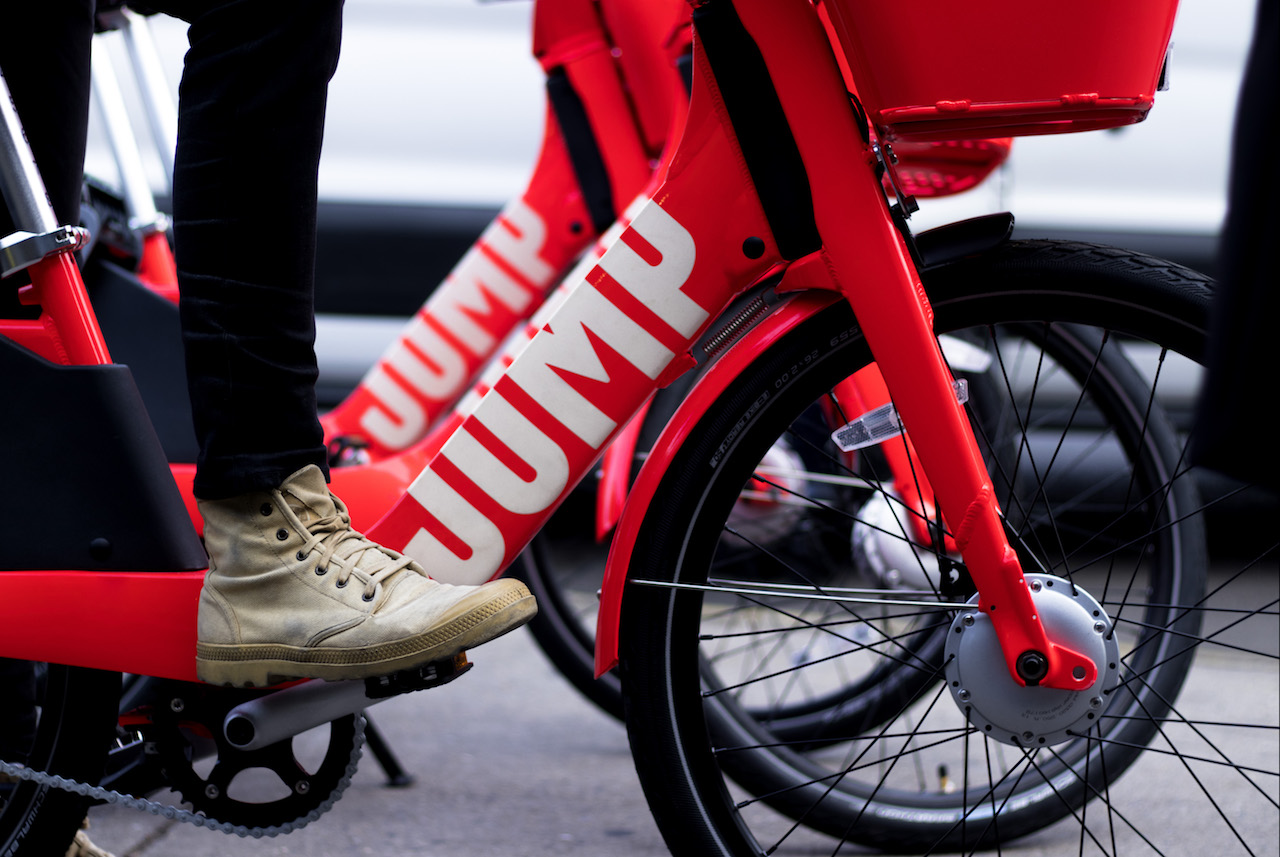JUMP! The Rise of Dockless Electric Bike Share Systems
 By Richard Schrubb
By Richard Schrubb
Dockless e-bike sharing programs are landing in major cities around the US and the rest of the world.
A development from the dockless traditional bike market, they both compete favourably in cost with public transport, and due to their range with private car use in many cases.
The media likes a good bad-news story and due to the stacks of dockless bikes left in major cities, there’s a bit of a hurdle to jump before such schemes become widely accepted – and loved – around the world.
Brooklyn, NY, based Jump Bikes is a development of Social Bikes, a traditional bike sharing scheme that has been running for nearly eight years and now has connections to 40 territories around the world.
There are now nine Jump Bikes e-bike sharing schemes in the US, Canada and Europe, and the company is running a pilot with Uber in San Francisco.
 Head of Product Nick Foley explained that their unique system will not result in stacks of dumped bikes on pavements because of the way they are locked.
Head of Product Nick Foley explained that their unique system will not result in stacks of dumped bikes on pavements because of the way they are locked.
Chinese bike share companies oFo and Mobike have locks that just lock the wheel.
Foley explained, “We have a lock that physically locks through something. You don’t see the level of chaos with ‘free locked’ bikes stacked on pavements”.
Essentially, with the user having to lock the bike to a railing one cannot just dump the machine in the way so many do with the ‘free lock’ system used on many rivals’ machines.
How They Operate
The way the user experiences the Jump Bike is that they find a bike on an app or nearby, reserve and unlock it using their app, and then use it on their trip.
In the US, the user is charged $2 for the first half hour and then per minute after that, at a rate of around $4 an hour. They then lock it to a railing when they have finished.
Foley said, “Most rides cost around $2 as the journeys are no more than 2-3 miles and under half an hour. This compares favourably with public transit, and incredibly favourably with taxis such as Uber where you could easily pay ten times the amount you’d pay for a Jump bike.”
There are several advantages to using an e-bike over using a traditional bike too.
The energy from the motor extends your range, and requires less energy to use so you will be less tired after an equivalent journey by bicycle for example.
This is borne out in the way people use Jump’s bikes. Foley said, “The average distance used on a shared e-bike versus a traditional shared bike is two times the distance. On our shared e-bikes you will see all the trips done on a bicycle (1-2 mile trips), but we are also seeing tons of traditionally car trips of 2-5 mile range.”
While there seems to be a definite replacement of car journeys by Jump e-bikes the company has no data available to suggest that they are killing off the car in the cities in which they operate.
The schemes in question have only been around a short time, but the signs suggest that long term there could be an impact.
Different User Groups
Another observation made by Foley was, “You are opening bike sharing to a drastically larger audience with the type of commutes you can serve. With the e-bike systems we have higher utilisation numbers. In addition to each bike being used for longer distances, the number of times an e-bike is used is way higher, and the types of people that use them is more diverse. We are reaching beyond traditional bike commuters to those who would not usually use a bike on their own.”
You don’t have to be young and fit to use a Jump e-bike.
The Jump e-bike sharing system also helps more people become economically active. The company has a number of low income programs in place around the world to enable people to get to work over longer distances.
“Having access to an electric bicycle that someone else maintains for you can make the difference between having a job and not having a job because you have no way of getting to it,” suggested Foley.
Good Neighbors
Good relations with the cities into which they work is core to the philosophy of running an e-bike sharing scheme well. Many cities are adopting a permit framework to control bike sharing.
“We respond to that framework and run a pilot. After that we increase the number of bikes until it gets to a scale that competes with other bike share schemes and meets the needs of the whole city.”
He continued, “We are aware of other bike share schemes that have launched thousands of bikes on a city overnight. We don’t believe people want change that quickly. That’s just not the right approach.”
Jump have found that because their individual e-bikes are so well used they don’t need so many machines on the streets. In San Francisco for example the company only has 250 machines on the streets. Ofo recently indicated they would like to put 100,000 on the streets of London in England!
Shared bikes are frequently abused and vandalised, but Jump have found that due to the relatively smaller numbers of bikes on the streets, this has resulted in as few as 1% of the machines being trashed.
Foley suggested, “A lot of people act out their frustration at the large numbers of machines that are like litter on their streets. Our high quality vehicles that are extremely well organised just don’t get that reaction.”
In the USA in particular these are often the first e-bikes people encounter. To that extent they are generally better received than when the public are presented with stacks of machines piled on street corners.
E-bike sharing schemes are going to be in large numbers of major cities around the world in the near future.
The best managed and most socially responsible ones will be those that encourage other cities to use them, and may well be the ones that stay in business while their misbehaving rivals are chased out of town.
-By Richard Schrubb
P.S. Don’t forget to join the Electric Bike Report community for updates from the electric bike world, plus ebike riding and maintenance tips!








Does anyone know when, where and how dockless electric bicycles get charged?
Yep. They are connected, so a control center can read the state of charge, and can get alerted when a bike is low or dead.
They have crews driving about town to do routine maintenance. Also to shuttle bikes to better locations. Or chargers.
Jump currently has two bike warehouses with charging docs. So the dockless bikes are…um…docking bikes. They offer incentives for riders to bring low-charge bikes to the warehouse.
The longer-term plan is to offer businesses incentives to install charging docks, and then to offer riders incentives to park the bikes there.
So, in the end, it will be like Uber’s “surge pricing”. Pay one price to leave the bike anywhere, dockless, or pay less to ride to a dock.
If there is a problem with a bike you rented, or the battery is low or dead at the end of your rental, you can signal the control center through the app, or a button right on the bike.
Also, they make no guarantees about the battery being full. You pay the same rate whether your battery lasts or dies on you.
In the app, before you rent a bike, you can see its state of charge. This is true whether the bike is in front of you, or two blocks away. You may not want to reserve a low/dead bike, and just find another.
The bike has a small solar panel on it. I can’t imagine it does much, given how much energy a motor uses, but it’s something. It will at least power the electronics, and the GPS and cellular IoT radio.
The timing of this article is good. I just went to San Francisco yesterday for a meeting, and rode on one of both the Ford bike share, and Jump.
Here are a few salient points:
– Peace of mind. Do you remember the feeling when you first used an Uber or Lyft, and you got out without paying or tipping, and thought “Is that it. It seems to easy. What am I forgetting?” But by the second time, you realized that this was a key FEATURE of the ride-share. No paperwork, no cash, no haggling. Well, bike share has the same awesome benefits. You finish your ride, and you’re done. It’s very clean and easy.
– Following on the above bullet, I want to bring up the AWESOME feature of “DE-RISK”. When I use my own bike in a city with crime like SF, I would lock it up very carefully, in a safe place, where I can see it, and I would take off my lights, my seat, etc. And then I would still worry about it. That’s because there is a very real risk of theft or damage to my $2,700 iZip bike. Now, compare that to using a shared bike. When I arrive at my destination, I complete the ride as specified by the share system, and BAM! I HAVE NO MORE RISK. I am completely free. I feel free, Like leaving the Uber for the first time, I feel like “Wow. I feel like I should be worrying about something…but I actually shouldn’t.”
– In both cases, you can either walk up to an available bike (or dock), enter your digits, and ride off. In both cases, you can also reserve the bike before you walk to it, and your 30-minute rental window starts from the time of reservation. All bike shares let you keep the bike longer than 30 minutes, but pricing varies and there are options like a day pass and more.
– Dockless is a way better user experience. The idea of these bikes is as a “last mile” or “short hop” transport solution. Last mile refers to people getting off a bus or a train, and trying to cover the final hop to work or home. Anyways, bikes that use docking stations just replace a public transit station last-mile hop with a docking station last-mile hop. So they don’t actually fix the problem they set out to solve. You basically don’t travel from where you are to where you want to go, you travel from docking station to docking station, much like transit stops. Dockless allows you to, at least, leave a bike at YOUR destination. You may have to walk to access the bike (the app tells you where to go, and you can reserve it so it waits for you).
– Jump tells users to park the bike safely, out of the way, at a bike rack. Users who consistently park badly get scored down, and eventually kicked off the system. This means that cities don’t need to provide space for docks, but they do need to have ample bike racks scattered everywhere.
– The Jump lock is a serious affair, with a solid piece of metal that attaches to a fixed bike rack or rail, and holds the bike there, as well as entering into the back wheel and immobilizing it. You can use the lock to end your ride, but also to temporarily lock a bike that you want to hold, for example while you pop into the 7-11.
– The Ford (and other docking systems), use smart docks to know where you are, where you rented and returned the bike, and to mange the fleet. The bikes are not connected. The dockless systems use GPS-enabled cellular-connected bikes, so they can track the bikes about time, locate them, find them, and help you find one close to you. The GPS enhances the security for the provider, and helps them recover lost bikes.
– The Ford did NOT have a lock built in. So if you have a quick errand, and want to ride the bike after popping in a shop or such, you have to bring your own lock. I didn’t have one, so I had to find a dock and end my ride. This is a serious negative. It not only forces one to have two separate rides to go to a shop, but it also means you can’t go to the shop, but rather must go to a dock.
– I’m worried about having too many bike shares in town, to where you have to have 5+ apps on your phone to find the nearest bike. It would be nice if there were just one bike share service in a town, or at least just one centralized app to find any bike. OTOH, I think competition is truly worth this inconvenience, as this market is so immature, and there are so many ideas that competition will allow to emerge.
– Strangely, the Ford bike is $3 for the first 30 minutes, while the Jump eBike is cheaper at $2.
– I’m a huge eBike fan, and my East Bay town is mostly flat. For San Francisco, en electrified bike is a HUGE benefit, given the hills. I was sweaty after my first Ford hop, but not at all after my second Jump hop.
– Bikeshare bikes, Jump and Ford included, tend to have lots of custom made parts, which make it less useful if stolen and disassembled. That’s a good idea to make theft less of a business. Look at the custom brake handles on the photo of the Jump bike in this article.
– Jump and Ford bikes had a low crossbar, easy for people to get on and off. Yet still both felt very solid, easy to ride.
– The Jump seatpost had clearly marked height numbers, so after your first ride, you could remember your preferred height, and just set the seat to that number on future rides. That’s the only adjustment to make.
– The Jump bike motor was in the front wheel, which was a slightly different feeling than the 7 ebikes I own. No big deal, maybe would matter on wet roads uphill, as traction would be compromised.
– Both apps track your rides over time, offering you total distances, calories burned, etc.
– Ford had a bungee on the carrier, Jump had a larger basket, no bungee.
– The Ford had an awesome NuVinci style continuous gearset. The Jump had a more conventional set of stepped gears, which, while inferior, matters less on an ebike.
– All bike share offerings suggest you bring your own helmet
– I’ve noticed a jump in the competition in this space. Competitors from the more mature market in China are expanding to the EU and North America, while VCs here in Silicon Valley are funding startups to the space. It seems like dockless is fueling another wave of enthusiasm. At CES, I saw a bunch of newcomers: Limebike, Jump, Scoot, and Spin. And also the Chinese vendors like Ofo, Mobike, and more.
Thanks for the great review of the systems Derek!